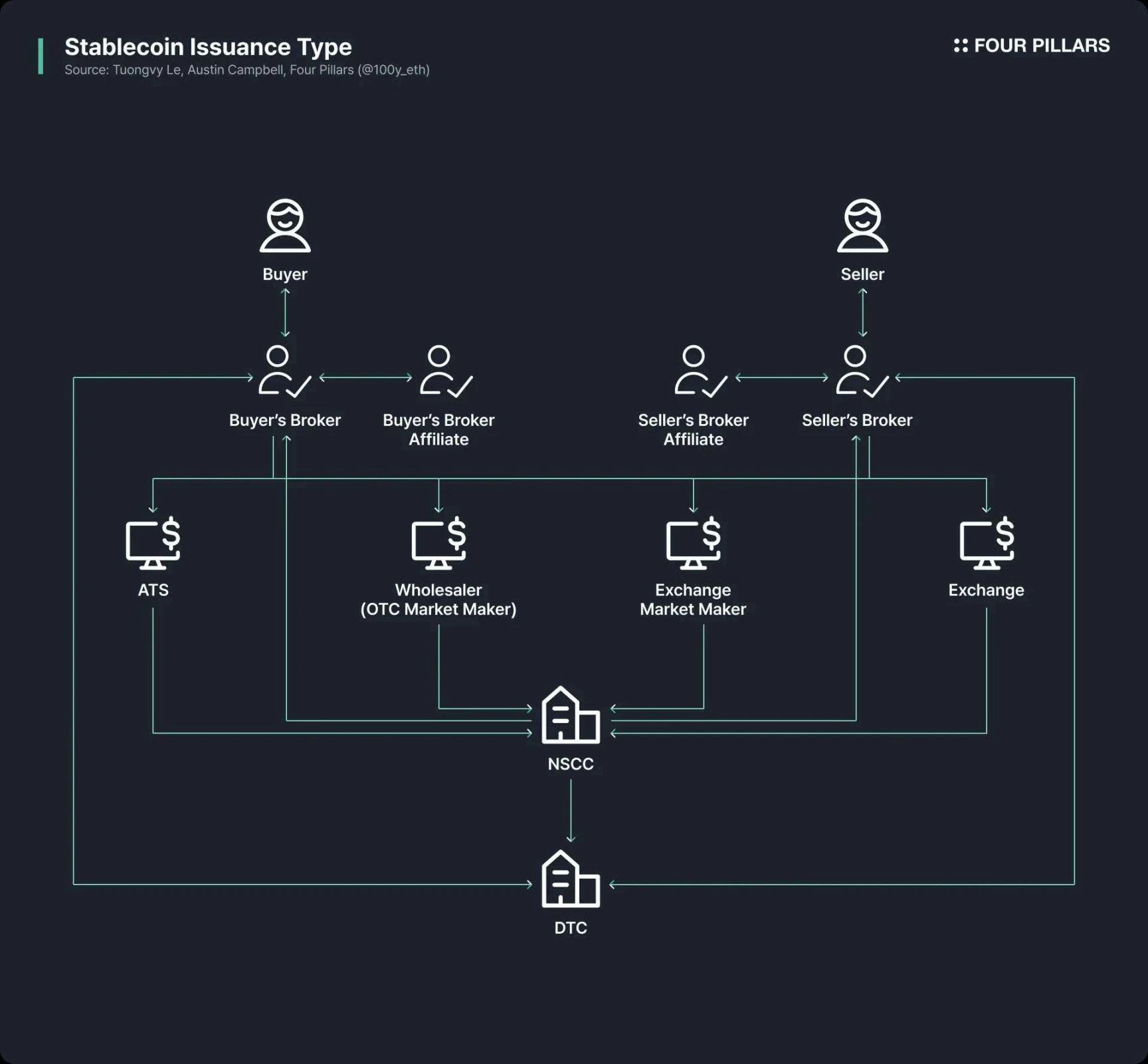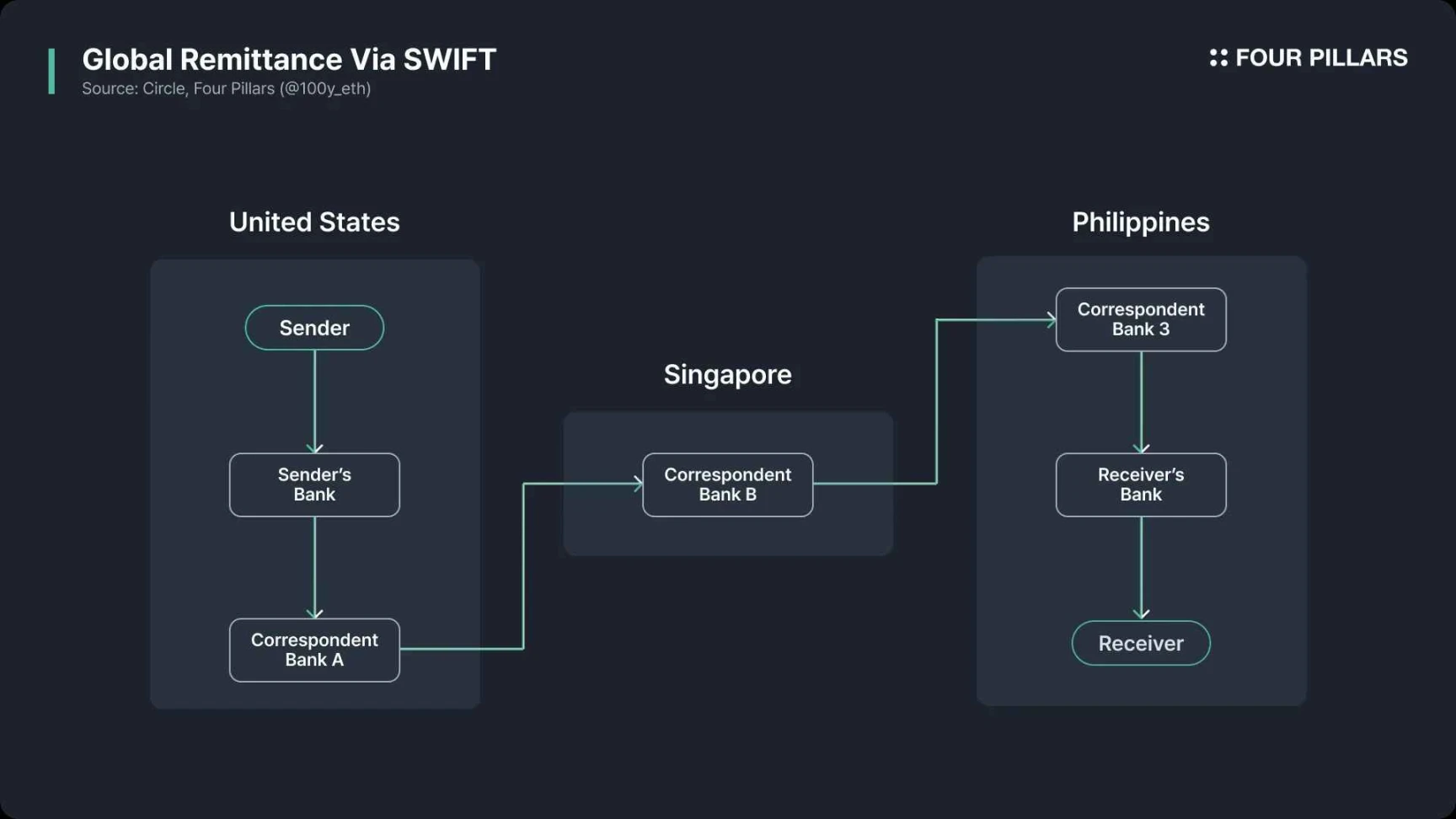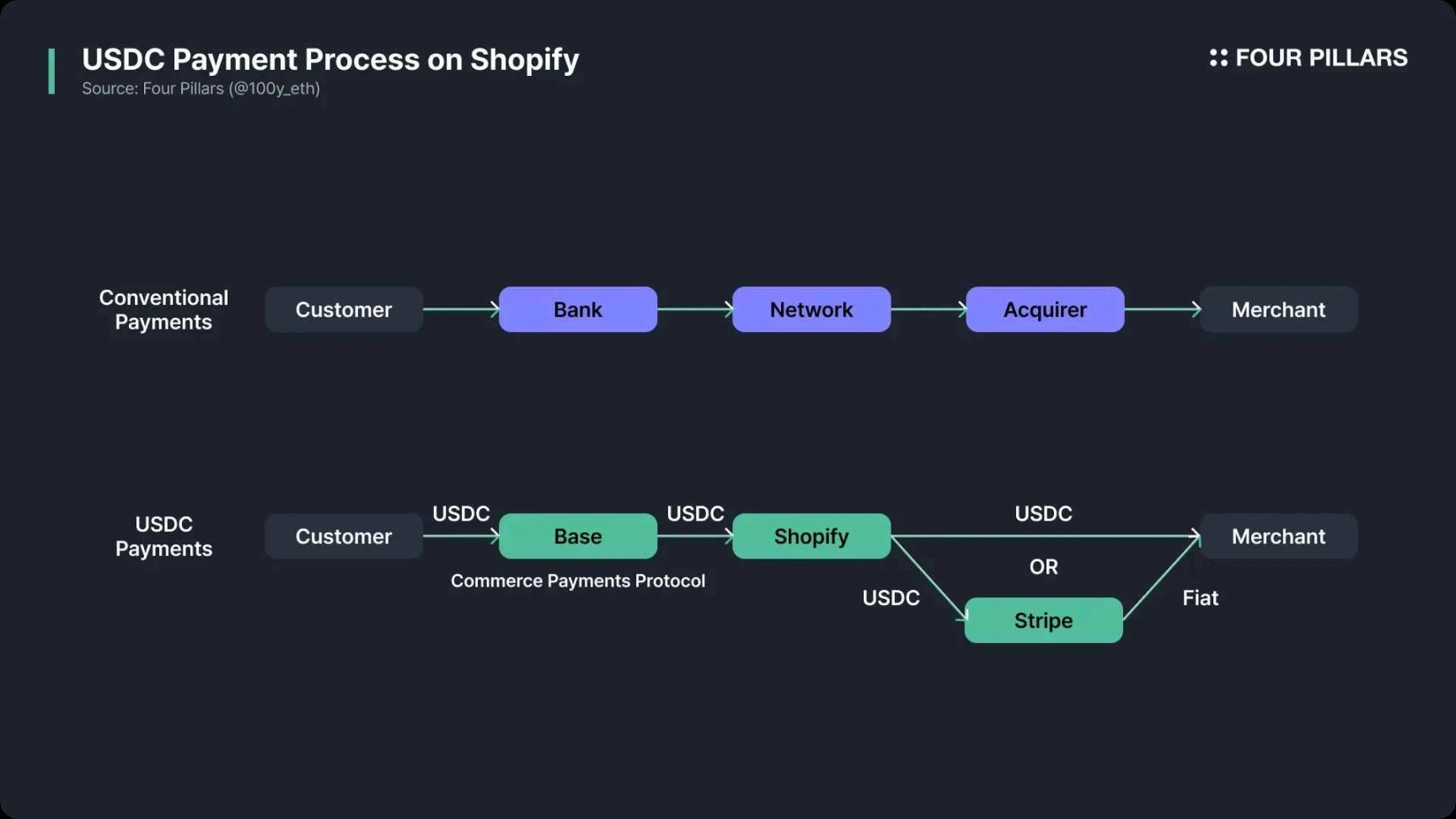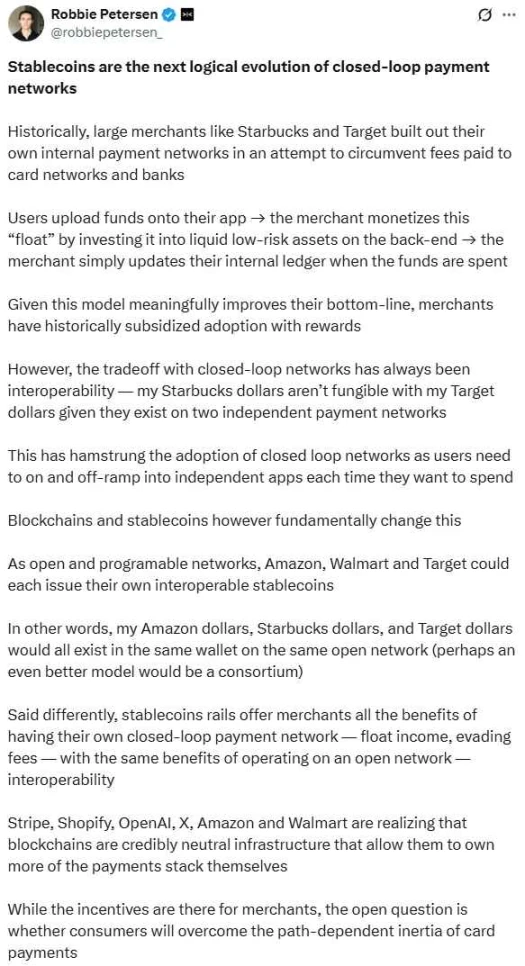Original title: When stablecoins set their sights on the payment market, can traditional payment giants still hold on to their thrones?
Original author: 100y
Original translation: Saoirse, Foresight News
Translators Note: Nowadays, stablecoins are no longer limited to the circle of cryptocurrency transactions. With the potential to change the backend of the financial system, it is quietly knocking on the door of the payment market. You may be curious about how this emerging role will shake up the traditional payment landscape? The answer is hidden in the article: on the one hand, it is trying to join hands with card organizations such as Visa and MasterCard to embed stablecoin functions in the existing network; on the other hand, it wants to bypass card organizations and banks and find another way to build a new payment system. PayPals PYUSD and Shopifys USDC payment system are both vivid examples of this change. Will stablecoins become a threat to traditional payment giants, or will they give birth to a new industry ecosystem? This article will explore the context and direction of this payment field change with you.
Although the current applications of stablecoins are mostly concentrated in the field of cryptocurrency trading, blockchain and stablecoins are expected to change the traditionally complex and huge financial system such as the securities market and payment system.
In recent years, the application of stablecoins in payment systems has become increasingly powerful. This trend is mainly advancing in two directions: 1) Integrating stablecoin functions with card organizations as the core; 2) Trying to completely bypass card organizations and issuing banks.
As for the latter, PayPals PYUSD and the USDC payment system jointly launched by Shopify, Coinbase and Stripe are typical cases. With the development of the stablecoin industry, it is expected that more companies with a large user and merchant base will build exclusive payment systems, which may pose a threat to banks and card organizations.
The use of stablecoins is still dominated by exchanges
Source: BCG
Stablecoins have attracted much attention both in the United States and around the world. There is a heated discussion about their innovative potential in remittances, payments, real-world assets (RWAs), interbank settlements, etc. However, according to a report by Boston Consulting Group (BCG), cryptocurrency transactions accounted for as much as 88% of stablecoin transactions in 2024. This data reflects the limitations of the current use of stablecoins, and they have not yet achieved the widespread real-world application we expect.
Stablecoins can fundamentally change the financial system
Although the advancement of financial technology has greatly optimized the user experience of the financial system, the back-end system that handles actual transactions still has problems with inefficiency and outdated technology. At this point, blockchain and stablecoins are expected to bring innovation to the back-end of the financial system. This is not just a supplement to the existing infrastructure, but it can provide a technology that can completely replace the existing model, just like the transformation of the financial system in history.
Securities Market

The reason why the back-end system of the securities market has become so complicated is due to the paperwork crisis that broke out in the US securities market in the 1960s and 1970s, and a series of policy measures introduced to solve the crisis. At that time, securities trading relied entirely on paper documents, and as the trading volume surged, the entire system was almost paralyzed. To this end, the US Congress passed the Securities Investor Protection Act (SIPA) and amended the Securities Act to establish a centralized clearing and settlement mechanism and an indirect securities holding system.
Initially, this system digitized securities ownership and improved settlement efficiency. However, it also made brokers, clearing houses, custodians and other intermediaries indispensable, which brought structural complexity and cost issues. Todays securities market is essentially the product of policy compromises and gradual improvements to overcome technological limitations. This system has been used for decades before more advanced technologies such as blockchain emerged.
Cross-border remittance
 The Society for Worldwide Interbank Financial Telecommunication (SWIFT) is currently the most widely used system in the field of cross-border remittances. It is a global messaging network jointly established by 239 banks in Brussels in 1973. It was created to replace the international interbank communication system based on telex at the time, which was slow and prone to errors. In addition, each bank adopted its own communication standards, resulting in poor compatibility, low efficiency and security risks. The emergence of SWIFT is to solve these problems and provide a set of universal communication standards and security networks.
The Society for Worldwide Interbank Financial Telecommunication (SWIFT) is currently the most widely used system in the field of cross-border remittances. It is a global messaging network jointly established by 239 banks in Brussels in 1973. It was created to replace the international interbank communication system based on telex at the time, which was slow and prone to errors. In addition, each bank adopted its own communication standards, resulting in poor compatibility, low efficiency and security risks. The emergence of SWIFT is to solve these problems and provide a set of universal communication standards and security networks.
However, SWIFT itself is only responsible for transmitting information. The actual flow of funds must be completed through the accounts of agent banks or central banks, and settlements between accounts are handled separately. The entire process involves multiple intermediary banks, and each bank will cause delays due to factors such as handling fees, KYC/AML audits, currency conversion, time zone differences, holidays, etc., which ultimately leads to high cross-border remittance costs and low transparency. If blockchain and stablecoins had been available at the time, information transmission and fund transfer could be completed on the same unified platform, and the efficiency of cross-border payment infrastructure would have made a qualitative leap.
Can stablecoins revolutionize the payment market?
Although people are discussing the innovative potential of stablecoins in multiple fields such as securities markets and cross-border remittances, the most anticipated next application scenario besides exchange trading is the payment system. In fact, in the payment field, not only Web3 companies, but also mainstream Web2 companies such as Visa, MasterCard, Stripe, and PayPal are actively exploring new business opportunities.
To determine whether stablecoins can truly change the existing payment system, we need to first understand how the current payment system works, the root causes of inefficiencies, and whether stablecoins can solve these problems.
How the current payment system works
Let’s first understand how the payment system works. When a customer pays a merchant, the process is as follows:
Authorization
The customer tries to complete payment by bank card.
The POS terminal or online payment gateway sends an authorization request containing the payment information to the acquirer.
The acquirer forwards the request to the card association (such as VisaNet, MasterCard Bank Network).
The card association passes the request to the issuing bank.
Verification
The issuing bank verifies the validity of the bank card, account balance, credit limit, and whether the transaction poses a suspicious risk.
Once verification is complete, the approval or rejection result will be returned to the acquirer through the card association.
If the transaction is approved, the corresponding amount will be temporarily frozen in the customers account.
If a transaction is declined, the merchant will receive feedback including the reason for the decline.
Capture
In some industries such as gas stations, hotels, and online shopping, the final amount is confirmed only after the initial authorization. Therefore, the moment when the merchant sends the debit confirmation request is the point at which the transaction is actually completed, and the request will be sent to the acquiring institution.
Batching
Authorized transactions throughout the day will be aggregated into a batch and sent to the acquiring institution at the end of business.
Clearing and Interchange
The acquirer sends the batch transaction data to the card scheme.
The card association sends each transaction to the corresponding issuing bank and calculates the interchange fee in the process.
Settlement
Funds are transferred from the settlement account of the issuing bank to the settlement account of the acquiring bank. The card organization will summarize daily transactions and generate settlement files to coordinate the settlement between the two parties, but the actual transfer of funds must be completed through the interbank payment network.
Funding
The acquirer deposits the payment amount, minus any applicable fees, into the merchant’s account, usually via an automated clearing house (ACH) or wire transfer.
Reconciliation
Finally, the merchant checks whether the received funds are consistent with his own records, and checks whether there are any problems such as discrepancies in amounts, missed transactions or duplicate charges.
What problems exist with the existing payment system?
The two main problems that are often criticized in traditional bank card systems are high fees and slow settlement speeds. Are these flaws inevitable, or can they be solved?
Source: a16z crypto
Payment Fee
Let’s first look at the composition of bank card payment fees. From the merchant’s perspective, bank card transactions involve three main types of fees:
Interchange fee: This fee accounts for the largest proportion and is charged by the issuing bank.
Card scheme service fee: the fee charged by the card scheme for transaction processing.
Acquirer Markup: A service fee charged by the acquiring bank.
Can blockchain and stablecoins reduce these fees? The first potential cost savings point is in global transactions. When merchants and cardholders are located in different countries, settlements must go through the SWIFT system, and replacing this process with blockchain or stablecoins can significantly reduce costs.
The second cost saving point is to bypass the card association and the issuing bank. The essence of the card association is the communication network connecting the customers bank and the merchants receiving bank. If stablecoin payment is fully adopted, customers can directly transfer money from their self-hosted stablecoin wallet to the merchants Web3 account through the blockchain network.
Settlement time
Next, let’s look at settlement time. Transaction authorization for bank card payments is completed almost in real time. In this regard, the scalability of public blockchain networks may be far less than that of centralized card organizations. However, in traditional bank card payments, clearing usually takes an additional 1-2 days, and settlement takes 1-5 days.
There are many reasons why settlement takes time, some of which can be solved and some of which are difficult to avoid:
Clearing cycle: Bank card payments usually aggregate daily transactions into batches and settle only once a day. Systems based entirely on blockchain or stablecoins do not need to follow this single-day clearing cycle.
Disputes, suspicious transactions, cancellations and refunds: Even with stablecoins, these issues cannot be eliminated. Since such situations are difficult to avoid during the payment process, settlement delays are still necessary.
Cross-border payments: When transacting across borders, funds need to be settled through the SWIFT system, which further increases delays. Blockchain can obviously provide a solution in this area.
Payment system based on stablecoin
Recently, various financial institutions and companies have turned to stablecoin-based payment systems. I believe that this major shift is mainly driven by two strategies: the first is led by card organizations such as Visa and MasterCard; the second is an attempt to completely bypass the card organizations and issuing banks.
Stable currency payment with card organization as the core
As I described in “ Visa and Mastercard: Designing the Next-Generation Payment System ,” Visa and Mastercard are actively exploring ways to integrate stablecoin functionality into their own infrastructure.
Crypto debit cards: These cards allow customers to pay using stablecoins stored in Web3 wallets or exchange accounts. Specifically, there are two ways to process customers stablecoins: one is to convert them into legal tender by the issuing bank and then process them through the existing payment system; the other is for the card organization to directly receive stablecoins through the funding account and then complete the transaction according to the traditional bank card payment process.
Stablecoin settlement: As mentioned above, card organizations can receive stablecoins through funding accounts, and can also use stablecoins to complete settlements with acquiring institutions.
In essence, stablecoin payments with card organizations as the core only add stablecoin payment and settlement support to the traditional system, and the participants and infrastructure remain unchanged. Therefore, this model has no significant advantages in terms of cost and timeliness. However, for customers and companies that natively use stablecoins, this model can save the capital in and out links and reduce transaction friction; in addition, if the entire payment process is settled in stablecoins, cross-border transactions will benefit significantly.
Attempts to bypass card associations and issuing banks
At the same time, some payment service providers (PSPs) have begun to bypass card organizations such as Visa and MasterCard and directly use stablecoins to process payments. Typical cases include PayPals PYUSD payment and the USDC payment solution jointly launched by Shopify, Coinbase and Stripe.
PYUSD Payment Solution
PayPal users can use their PYUSD balance to complete payments within their app. These PYUSD are not stored in the users personal wallet, but are held by Paxos, the issuer of PYUSD. When a PYUSD payment occurs, there is no actual on-chain transfer operation, but an internal transfer of PYUSD ownership from the customer to the merchant is completed in PayPals backend system. If the merchant wishes to settle in fiat currency, PayPal will convert PYUSD into US dollars at a ratio of 1:1 and transfer the funds to the merchant account through banking networks such as ACH (Automated Clearing House).
If the customers PYUSD balance is insufficient, they can top up through their bank account or bank card (fees may be incurred); similarly, if the merchant requires legal currency settlement, processing through the bank network will also incur additional fees and time costs. However, if the entire payment cycle is completed with PYUSD, there is no need to go through the card organization or issuing bank, which can significantly shorten the time and reduce costs.
Shopify launches payment solution with Coinbase and Stripe

Unlike PayPal, which uses stablecoins in the payment process but does not directly involve the blockchain network, Shopifys USDC payment solution goes a step further.
In June 2025, Shopify announced a partnership with Coinbase and Stripe to integrate USDC payments into Shopify Payments. When customers check out at Shopify stores, they can choose USDC as a payment method and complete the payment by connecting to a crypto wallet holding USDC on the Base network.
In this process, the smart contract Commercial Payment Agreement on the Base network uses the traditional authorization first, deduction later model to complete payment authorization in advance, and the actual fund transfer is delayed. Shopify and Coinbase will summarize the USDC transaction data of the day and complete the settlement on the Base network.
The default settlement method is: Shopify converts USDC into the legal currency of the merchants region through Stripes infrastructure, and then deposits it into the merchants account through bank payment networks such as ACH or SEPA. Merchants can also choose to receive settlement funds directly in USDC to get the money faster.
Summary and Thoughts
The most frequently asked question about stablecoin-based payment systems is: Since blockchain transactions are inherently irreversible, how do you handle cancellations or refunds? Although a completely peer-to-peer payment system may eventually emerge between customers and merchants, problems such as fraud detection, chargebacks, and refunds will always exist, so intermediaries in the payment process are still necessary. It can be seen that the roles of card organizations and issuing banks, which traditionally assume these functions, will not completely disappear.
However, in the above-mentioned stablecoin payment cases of PayPal and Shopify, intermediaries such as PayPal and Stripe played the role of payment service providers (PSP), responsible for handling fraud detection, transaction cancellations, refunds, etc. Specifically, PYUSD transactions are not processed on the chain, but completed in PayPals backend system, which leaves room for dispute resolution; in the case of Shopify, the Commercial Payment Agreement smart contract on the Base network did not approve the payment immediately, but introduced a buffer time to handle possible disputes. In addition, Circle, the issuer of USDC, has also launched a Refund Protocol for non-custodial dispute resolution in stablecoin payments.

Source: X (@robbiepetersen_)
Payments based on stablecoins are an inevitable trend in the future. The issuance link is crucial, and the circulation link cannot be ignored. As Robbie Petersen of Dragonfly pointed out, companies that already have a large merchant and user base will increasingly adopt stablecoin payments, thereby bypassing card organizations and issuing banks. Stablecoins may even enable interconnection between such closed-loop payment systems. Given these trends, stablecoins may pose a real threat to card organizations and issuing banks, and they need to explore new opportunities in this unstoppable wave of stablecoins.
【Disclaimer】The market is risky, so be cautious when investing. This article does not constitute investment advice, and users should consider whether any opinions, views or conclusions in this article are suitable for their specific circumstances. Investing based on this is at your own risk.















